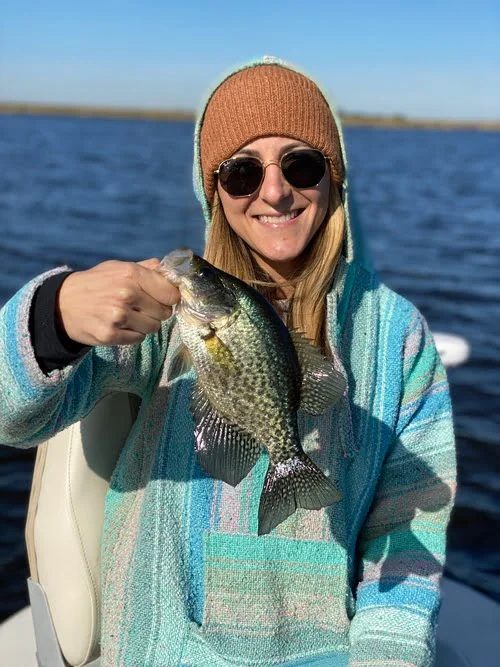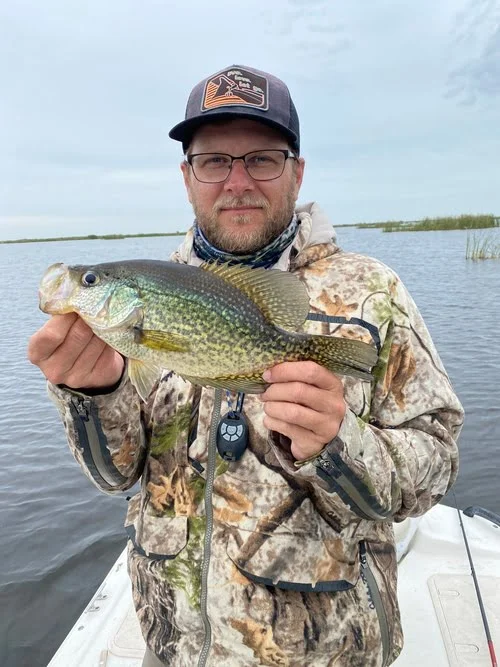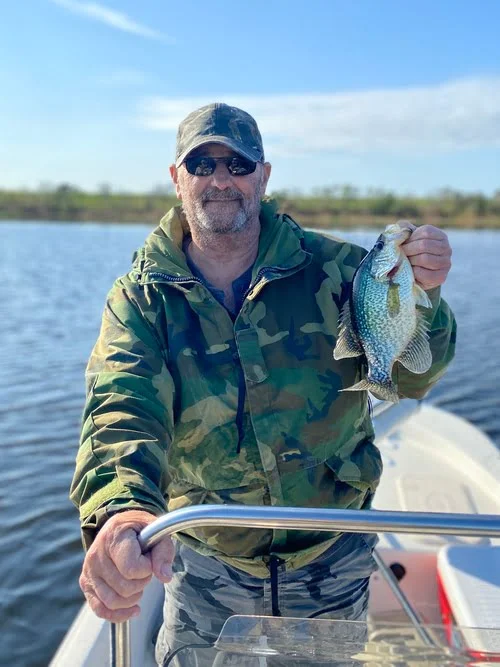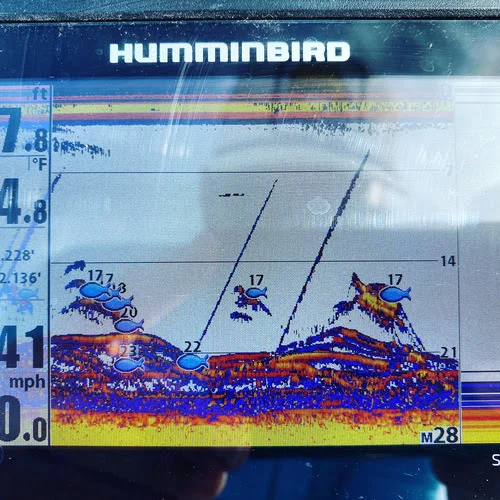Winter fishing for crappie presents a unique set of challenges: Cold temperatures, inclement weather and a change in fish patterns and behavior.
But, it also present a great opportunity. Many die-hard crappie anglers will tell you the best time of year to catch crappie is during the winter.
In this article i’m going to share everything you need to know to get started.
Table of Contents
Can You Catch Crappie in the Winter?
Crappie fishing during the winter months can be challenging, but it also presents a great opportunity for the persistent angler. The biggest challenge is usually locating schooling crappie, however once they’re found, this can be a consistent fishing spot for weeks or even months.
Crappie are quite cold tolerant species, compared to many other popular game fish, and in the winter they are generally more active than bass and bluegill.

However, crappie are not completely unaffected by the cold winter weather, and their feeding and behavior changes this time of year.
Knowing where to look and what baits to use will greatly improve your crappie fishing success this winter.
Fortunately for crappie anglers, crappie are very adaptable fish, and they can tolerate a wide range of temperatures.
Black and White Crappie are cold blooded animals, and their activity depends on the temperature of their environment. As temperatures decrease, their metabolism slows down, and they don’t have to eat as much.
When winter temperatures get really cold, and the water freezes over, fish can enter a state of dormancy known as torpor, which can be compared to hibernation but for fish. During this state, fish eat less and often lay motionless to conserve energy.
Crappie still have to feed this time of year, so you can catch them during the winter. Crappie fishing during the winter can be highly productive, and even if your lake freezes over, ice fishing is a great way to catch crappie.
How Do You Catch Crappie During the Winter?
The difficulty you will have catching crappie depends on the severity of the winter. In the deep south, where winter temperatures are quite mild, it’s one of the best time of year to catch crappie.
However, in the northern ranges, where lakes and ponds may freeze over, crappie retreat to deeper water where conditions are more stable. In general, crappie are less active during the coldest weather.
The first and most important thing to do during the winter is to use smaller presentations and fish slower. Unlike the spring time, where spawning crappie will chase down and eat a wide variety of foods, during the winter, crappie can become slow moving and very picky, so focus on slow and subtle bait presentations.
One inch ice jigs or micro spoons, for example, are ideal for winter crappie fishing. They are super effective in open water and through the ice.
These both work great when tipped soft plastic trailers, like the Eurotackle Y-Fry, or with a live bait, like a small live minnow or wax worm.

During the winter, crappie have less energy for feeding, and they do not want to waste their energy. In the winter, chasing down a fast moving prey or tackling prey which is too big and may escape is too much effort for a crappie.
In order to save energy, crappie often just barely nip at tiny slow moving prey which are suspended in the water column or crawling along the bottom.
Where to Find Crappie in the Winter?
Unlike many other sunfish, crappie are nomadic and frequently move around great distances in their watershed to find food. This makes finding them during the winter somewhat tricky, so covering water is a good strategy.
In the winter, crappie roam their habitat and search out the best feeding areas based on three main things. These are temperature, oxygen, and food availability. Structure is also important, and it is an easy way to locate a likely place for fish to congregate.
Crappie often follow the baitfish around their environment. Look for baitfish flickering at the surface or suspended over deeper water. Feeding birds can also be a good indicator.
Don’t be afraid to fish larger bodies of water during the winter. Bigger bodies of water, like large lakes or reservoirs, have plenty of food and the deep water refuge necessary to support big crappie during the winter.
Often smaller bodies of water, like little creeks or ponds, don’t have enough food or deep water to support many fish during the winter.
In some lakes, grass may die off in the winter, but if you can find it, grass is another good sign to look for! Grassy areas will attract hungry fish, because they have plenty of food for crappie, like crustaceans, insect larvae, and baitfish.
Deeper grass lines, from 8 to 20 ft, can be especially productive during the winter, even through the ice.
See Also: Ice Fishing For Crappie At Night? Tips To Get Started!
What Depth to Find Crappie in the Winter
Wintertime crappie can predictably be found between 20 to 40 feet deep. However, they can quite often be deeper or shallower depending on the habitat, forage, and weather conditions.
For example, on lakes and reservoirs, crappie are often found suspended over the deepest, often featureless portions of the lake.
Knowing your lake’s depth transitions and structural features is important this time of year. If you have a map of your lake, this will help you greatly compared to going in blind.
Use lake maps to your advantage, if you can find them, and look for depth contours for your lake. Search your maps for deeper areas adjacent to the shallows or with nearby structures.
These will certainly hold crappie during the winter because they have access to stable temperatures, a good food supply, and protection from larger predators.
Good news for bank fishing crappie anglers, the best areas aren’t necessarily always the middle of the lake. Look for steep banks which may indicate deep water close to shore.
Deep areas with structure such as submerged logs, rocks, or grass are good places to look for crappie during the winter.
If you’re having trouble finding fish, or just want some extra help, consider using a fish finder or livescope. These are useful if you’re on a boat or kayak, but they also work while ice fishing. Underwater cameras are also very helpful when ice fishing.
What Do Crappie Eat in the Winter?
In the winter, most crappie eat some of the tiniest baits in the lake. Stomach content analysis of crappie shows zooplankton, like daphnia, are a staple part of crappie diets in the winter. Insect larvae, such as larval dragonflies, mayflies, and caddisflies, are eaten by crappie this time of year, and small crustaceans are also on the menu.
In larger lakes with an abundance of baitfish, the larger crappies eat mostly fish. Shiners, shad, and silversides are common bait fish that swim in the middle of the water column.
Crappie feeding on baitfish are generally suspended in deep, high oxygenated parts of the lake.
What are the Best Crappie Baits During the Winter?
Live bait is a great way to catch crappie during the winter. Small live minnows or threadfin shad are a perfect option to target those trophy dinner plate crappie in the winter. Wax worms and maggots are also good baits for crappie, especially for ice fishing.
In the winter, in open water and for ice fishing, live baits are best rigged on a jighead, a dropshot, or under a float.
Try not to move your live bait excessively. Ideally, you should keep bait stationary and let the natural action of the bait entice the fish.

Even if there is no wind, or current, your bait still has natural movement in the water that crappie can see with their large eyes.
In the winter time, crappie often just nip at the bait and may quickly spit the bait out. That’s why, if you’re bait fishing, do your best to watch your line and feel the bites.
This helps your hook up ratio and also helps to avoid irresponsibly gut hooking fish for catch and release fishing.
Best Artificial Lures For Crappie During the Winter?
If you prefer artificial lures, you’re in luck, because a variety of artificial lures work great for crappie in the winter!
Tiny ice jigs tipped with 1 inch plastics, like the Eurotackle Y-fry or Gulp Minnow are amazing crappie fishing in open water and through the ice. Ultralight jigging spoons, less than two inch in length, like the Eurotackle T-Flasher are equally as effective this time of year.
These lures are best when fished vertically, from a boat, a dock, or through the ice.
Let the lure sink to the desired depth and give very subtle bounces with the rod. You should not jig too aggressively in the winter, because this is likely to scare off fish.
Tungsten jig heads and spoons are usually preferred for this style of fishing because they sink faster and are more sensitive than traditional lead jigs. This helps you fish deeper water and feel the most sensitive bites on your lure.
You May Also Like: The Best Minnow Fishing Lures For Bass, Trout & Crappie
Do Crappie School Up In The Winter?
In my experience, crappie are more likely to school up during the winter once they have found a stable, and highly oxygenated area with food.

If you can locate one of these areas (remember, check your lake maps for deep submerged cover, holes, and other features), you may stumble on a mega school of crappie.
An area like this can produce great fishing week after week during the winter, until water temperatures force a change in crappie behavior and they move shallow for the spawn.
Conclusion
Crappie fishing during the winter can be very productive, but it may take some time to find where the fish are located.
Use the resources available such as lake maps, electronics, google earth and even word of mouth to find where those ‘winter crappie holes’ are located.
After you find the crappie, chances are they are going to stay in that same area for weeks at a time…which means you have a consistent spot you can return to and fish during the cold months.
During that time, remember to focus on smaller presentations and subtle baits. Make it easy on the crappie, drop your jig down and let it sit. If they are feeding, they’ll find it!
Good luck and thanks for reading.
If you haven’t guessed yet, I love fishing and everything about it!
To learn more about why I started Panfish Nation, visit the About page and follow along on Social Media:


Download a copy of my FREE Lure Color Selection Chart & Knot Guide!
Stay up to date with fishing reports, tackle reviews, industry news, and much more! We respect your privacy, unsubscribe at any time.
